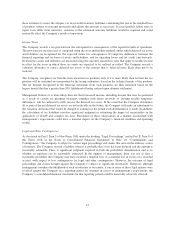Apple 2013 Annual Report Download - page 35
Download and view the complete annual report
Please find page 35 of the 2013 Apple annual report below. You can navigate through the pages in the report by either clicking on the pages listed below, or by using the keyword search tool below to find specific information within the annual report.
warranty costs; price reductions on certain products, including iPad 2 and iPhone 4; and unfavorable impact from
foreign exchange fluctuations.
The gross margin percentage in 2012 was 43.9%, compared to 40.5% in 2011. This year-over-year increase in
gross margin was largely driven by lower commodity and other product costs, a higher mix of iPhone sales, and
improved leverage on fixed costs from higher net sales. The increase in gross margin was partially offset by the
impact of a stronger U.S. dollar. The gross margin percentage during the first half of 2012 was 45.9% compared
to 41.4% during the second half of 2012. The primary drivers of higher gross margin in the first half of 2012
compared to the second half are a higher mix of iPhone sales and improved leverage on fixed costs from higher
net sales. Additionally, gross margin in the second half of 2012 was also affected by the introduction of new
products with flat pricing that have higher cost structures and deliver greater value to customers, price reductions
on certain existing products, higher transition costs associated with product launches, and continued
strengthening of the U.S. dollar; partially offset by lower commodity costs.
The Company anticipates gross margin during the first quarter of 2014 to be between 36.5% and 37.5%. The
foregoing statement regarding the Company’s expected gross margin percentage in the first quarter of 2014 is
forward-looking and could differ from actual results. The Company’s future gross margin can be impacted by
multiple factors including, but not limited to those set forth above in Part I, Item 1A of this Form 10-K under the
heading “Risk Factors” and those described in this paragraph. In general, gross margins and margins on
individual products will remain under downward pressure due to a variety of factors, including continued
industry wide global product pricing pressures, increased competition, compressed product life cycles, product
transitions, potential increases in the cost of components, and potential strengthening of the U.S. dollar, as well
as potential increases in the costs of outside manufacturing services and a potential shift in the Company’s sales
mix towards products with lower gross margins. In response to competitive pressures, the Company expects it
will continue to take product pricing actions, which would adversely affect gross margins. Gross margins could
also be affected by the Company’s ability to manage product quality and warranty costs effectively and to
stimulate demand for certain of its products. Due to the Company’s significant international operations, financial
results can be significantly affected in the short-term by fluctuations in exchange rates.
Operating Expenses
Operating expenses for 2013, 2012 and 2011 are as follows (in millions, except for percentages):
2013 Change 2012 Change 2011
Research and development ............................. $ 4,475 32% $ 3,381 39% $ 2,429
Percentage of total net sales ........................ 3% 2% 2%
Selling, general and administrative ....................... $10,830 8% $10,040 32% $ 7,599
Percentage of total net sales ........................ 6% 6% 7%
Total operating expenses ............................... $15,305 14% $13,421 34% $10,028
Percentage of total net sales ........................ 9% 9% 9%
Research and Development (“R&D”) Expense
The growth in R&D expense was driven by an increase in headcount and related expenses to support expanded
R&D activities. Although total R&D expense increased 32% and 39% in 2013 and 2012, respectively, it
remained fairly consistent as a percentage of net sales. The Company continues to believe that focused
investments in R&D are critical to its future growth and competitive position in the marketplace and are directly
related to timely development of new and enhanced products that are central to the Company’s core business
strategy. As such, the Company expects to make further investments in R&D to remain competitive.
Selling, General and Administrative (“SG&A”) Expense
The growth in SG&A during 2013 was primarily due to the Company’s continued expansion of its Retail
segment and increased headcount and related expenses, partially offset by decreased spending on professional
33
























